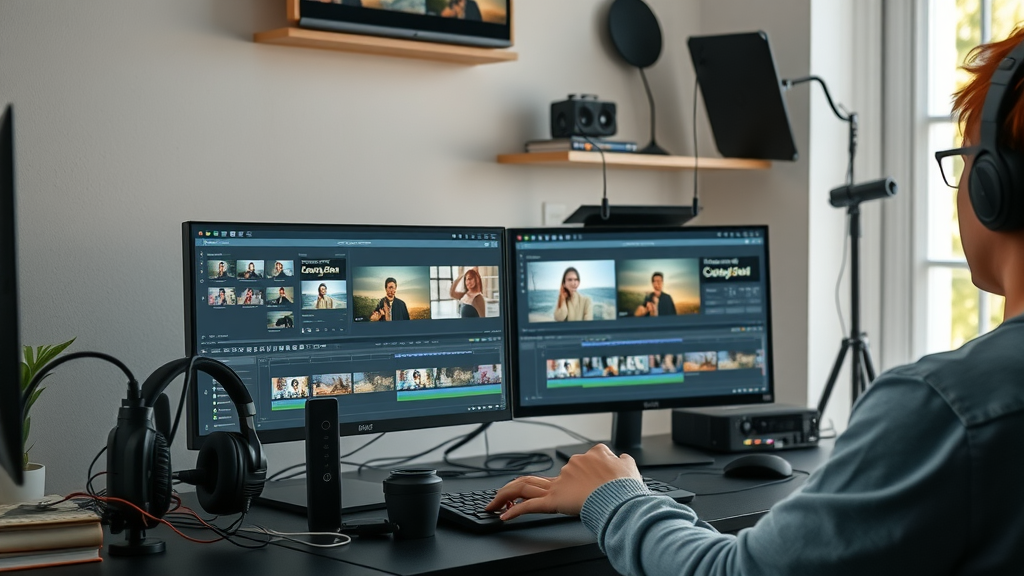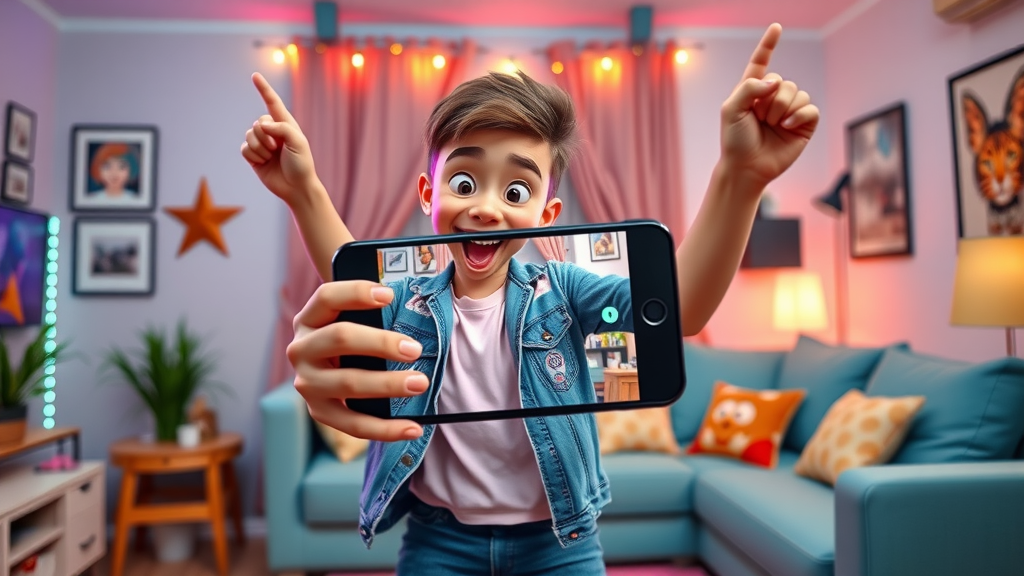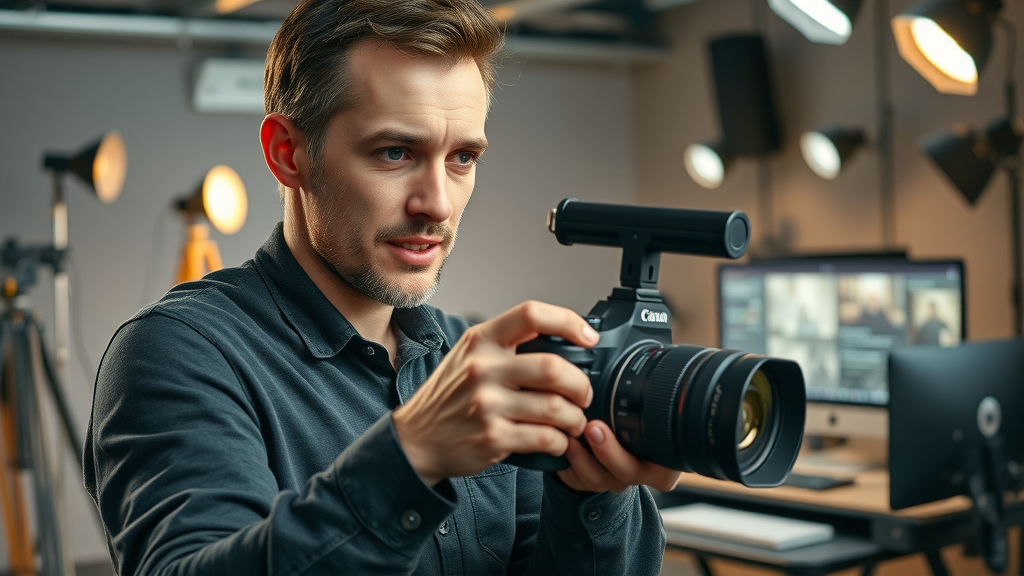Did you know? Video content creation is projected to account for a staggering 82% of all internet traffic by 2025. That means mastering how to create quality video content today isn’t just an option—it's your ticket to standing out in the ever-evolving world of online media. Whether you're an aspiring content creator or a seasoned pro, this guide is packed with actionable insights to help you build, edit, and promote engaging videos with less effort and bigger results.
- Did you know that video content creation is projected to account for 82% of all internet traffic by 2025? Discover how mastering video content creation can put you ahead in an ever-evolving digital landscape.

Achieving Success with Video Content Creation: Essential Foundations for Content Creators
- Understand what video content creation means today
- Practical examples of high-performing video content
- How content creators leverage video to engage their target audience
Video content creation has become a vital element in the digital communication toolkit for brands, businesses, and individuals. Today, content creators craft everything from short videos for social media to detailed how-tos and high-impact marketing videos just to keep pace with audiences’ ever-shrinking attention spans. Online video isn’t just trending—it’s the default way to inform, entertain, and influence. Successful creators aren’t just making random videos; they research their target audience , analyze media platform trends, and deliver content that’s timely and relevant.
Take, for example, how a YouTube channel with regular, well-edited tutorials consistently outperforms bland, one-off uploads. Or consider social thumbnails that use smart visuals and strong metadata to boost discoverability on every social media platform . Whether sharing marketing video case studies, a quick media video on Instagram Reels, or a professional video for LinkedIn, adaptable content creation is what drives meaningful engagement and builds loyal online communities.
The most engaging videos start with a deep understanding of both content marketing strategy and the platforms they serve. As a content creator , the goal is not just to create content but to ignite conversations, foster community, and meet viewers right where their needs are—on YouTube, TikTok, or the front page of Google’s search engine. That’s the unbeatable foundation of effective video content creation .

Setting Your Strategy: Identifying Your Target Audience and Platform for Video Content Creation
- Defining goals for your video content creation journey
- Choosing the right social media platform, from YouTube video to Instagram Reels
- Understanding your target audience for maximum engagement
Before you hit “record,” clarify what you want to achieve through your video content creation efforts. Start by asking yourself: Are you aiming to educate, inspire, sell, or entertain? These goals shape every creative and strategic decision—from your content planning routines to your scripting style. By establishing clear objectives, you gain a compass for choosing formats (think online video demos for products, or marketing video testimonials for services) and measuring success later on.
Next up: platform selection. Start where your target audience already spends time. If your niche loves long-form explainers, YouTube video is a no-brainer. For behind-the-scenes or quick, viral moments, Instagram Reels and TikTok shine. Every social media platform has its own rules. Facebook’s algorithm favors share-worthy moments, while LinkedIn cherishes professional video insights. Choosing wisely ensures your efforts aren’t wasted on the wrong crowd.
Finally, research your viewers. Learn their pain points, language, and preferences with surveys, comment monitoring, and competitor benchmarking. Create content tailored specifically to them—for example, using a relatable story in a media video or delivering quick value in a short video . By knowing and understanding your target audience intimately, you maximize reach, retention, and actionable engagement in any video content creation journey.
Video Content Planning: Content Calendar and Consistency Tips
- Building an editorial calendar for consistent video content
- Frequency and optimal posting times for each media platform
Planning is the unsung hero of steady video content creation . Successful content creators swear by editorial calendars, which help organize ideas, batch shoot videos, and keep posting consistent. With a dedicated calendar, you map out themes (like tutorials, Q&As, or vlogs), upcoming holidays, and new product launches for your media platform . This big-picture view avoids content fatigue and last-minute scrambling, resulting in a more polished quality content feed.
Consistency is as much about timing as it is about quantity. Analyze your platform’s analytics to reveal the best days and hours for maximum engagement. Posting too much overwhelms your audience, while too little makes your brand forgettable. For most, sticking to one or two uploads per week—with extra bite-sized content for stories or shorts—keeps viewers hooked and algorithms happy.
Pro tip: Use reminders and automation tools, like Buffer or Hootsuite, to publish on schedule, freeing up creative energy for actual content production and keeping your workflow stress-free. Over time, this discipline is what levels up your standing as a trusted content creator .

Creating Video Content: From Concept to Execution
- Step-by-step process for creating video content
- Choosing formats: marketing video, professional video, educational video, and more
- How content creators brainstorm engaging topics
Let’s break the video content creation process down into actionable steps for creators at any level. Start with ideation: Jot down content ideas inspired by trending topics, frequently asked questions, competitor analysis, or even audience suggestions. Not every concept will become a masterpiece, but brainstorming regularly gives you a rich pool to pull from. Next, decide the right video format—tutorials for step-by-step guidance, marketing videos to highlight services, professional videos for business branding, or quick media videos for social sharing.
Once you lock your concept and format, move briskly through video production : gather your gear, set up lighting, write your script, and storyboard your shots. High-caliber content creators always plan ahead to prevent wasted time and avoid repetitive takes. Whether you’re going solo or with a small crew, prepping minimizes errors during recording and sets the stage for a smoother editing process.
Engaging video content comes from workshopping several ideas, whittling them down, and always asking: “Will this serve my audience’s needs?” If you’re unsure, beta test with a small group and invite honest feedback. Keeping this iterative mindset is what transforms sporadic uploads into a winning video content series.
Scripting and Storyboarding: Structure for Quality Video Content Creation
- Benefits of storyboarding and scripting for video production
- Examples and templates for compelling videos
A solid script is the backbone of any quality video . By mapping out your narrative, voiceovers, and key talking points, you avoid rambling, stay on message, and deliver a tighter edit. Storyboarding—creating a visual plan for each scene—streamlines your entire video production process, clarifies camera angles, and ensures you capture every critical shot the first time.
Consider using storyboarding templates or whiteboards to lay out your ideas visually. Even a simple series of sticky notes representing different scenes can make a world of difference. Top content creators routinely storyboard both intricate marketing videos and straightforward how-tos, which helps keep their episodes on-brand and fresh.
For example, a social media influencer might script punchy hooks up front and map out dynamic visuals with quick edits, while a B2B expert uses scripts to ensure clarity, authority, and step-by-step learning. Remember, a great script and storyboard minimize editing headaches and maximize audience attention.

Essential Tools for Effortless Video Content Creation
- Overview of must-have video editing software
- Best video editor tools for beginners and pros
- Affordable equipment for online video production
Picking the right gear and editing software can turn daunting video content creation into a streamlined workflow fit for beginners and professionals alike. For hardware, you don’t need to max out your credit card. Start with a good smartphone, a steady tripod, and a ring light for crisp visuals—then grow your toolkit as your channel does. Affordable lavalier microphones also dramatically boost sound quality without needing a studio setup.
The market is full of video editor options. Beginners love the simplicity of iMovie, Windows Video Editor, or CapCut. As you progress, DaVinci Resolve and Adobe Premiere Pro offer advanced features for complex edits, while Final Cut Pro is a favorite among Mac users. Cloud-based options like Canva and Clipchamp are brilliant for quick social media videos and straightforward video editing on the go.
The right mix of gear and software reduces friction in production, freeing you to focus on content that matters. Next, see our quick comparison for help choosing your next video editor :
| Software | Best For | Key Features | Platforms | Price |
|---|---|---|---|---|
| iMovie | Beginners, quick edits | Drag & drop, color correction | Mac, iOS | Free |
| DaVinci Resolve | Pros, color grading | Advanced editing, effects | Win, Mac, Linux | Free/$295 |
| Adobe Premiere Pro | Professional editing | Multi-track, integration | Win, Mac | Subscription |
| CapCut | Social media, mobile | Filters, captions, AI tools | Web, iOS, Android | Free |

Maximizing Efficiency: Tips for Fast Video Editing Without Sacrificing Quality
- Batch processing and editing tricks
- Leveraging templates and video editor automation
Editing can eat up hours—but smart time-savers can boost both speed and quality video without cutting corners. Batch process by grouping similar tasks: import all your footage, edit rough cuts for several videos at once, apply consistent color corrections, and only then add text or animations. This assembly-line approach minimizes tool-swapping and decision fatigue.
Tap into pre-made templates for intros, outros, or transitions—most top-tier editing software offers libraries to keep branding uniform without starting from scratch. Automation features, like automatic captioning or clip sorting, are supported in newer editors and save countless hours.
As one leading creator advises:
"A great story is at the heart of every memorable video – focus on substance over flash." — Leading Video Content Creator
Production Best Practices: Shooting and Editing High-Quality Video Content
- Video production essentials: lighting, sound, stabilization
- Tips for mobile video content creation
- Editing video content for professional results
To create professional video content, never skimp on the basics: light your scene from the front and side for clarity; record audio close to the subject (external mics trump built-ins); and stabilize your camera with a tripod even when shooting on a phone. These simple upgrades instantly separate amateur clips from high-quality, engaging videos. If you're on the move, invest in a compact gimbal or phone tripod for buttery-smooth footage—a quick win for anyone creating video on Instagram, YouTube, or TikTok.
Mobile creators can unlock pro-level quality with just a few accessory tweaks. Use built-in night mode or manual exposure controls for tricky lighting. Shoot horizontally for YouTube and Facebook, but go vertical for Stories, Shorts, and Reels. A little planning keeps your edits tight and reduces time spent "fixing it in post."
Pro editing isn't just about flashy effects; it's about trimming the fluff, maintaining pacing, and balancing audio levels. Crop in for reactions, insert text overlays for clarity, and pay close attention to sound design—your viewers will notice. Each element, from lighting to finishing edits, contributes to a cohesive, binge-worthy video content catalog.

Post-Production Tips: Elevate Your Video Content Creation with Polished Editing
- Choosing music, sound effects, and transitions
- Ensuring your video content is optimized for various media platforms
Post-production is when good videos become great. Choose royalty-free background music and crisp sound effects to strengthen tone without overwhelming voiceovers. Simple transitions (cross-fades, wipes) keep viewers oriented as scenes change, while color grading unifies your footage into a signature professional style.
A key step in video content creation is platform-specific optimization. Crop and export dimensions based on where your audience watches: square (1:1) for Instagram feeds, vertical (9:16) for Stories and TikTok, horizontal (16:9) for YouTube. Add captions for accessibility and stronger engagement—a must for silent autoplays on most social media platforms .
Finally, compress video files judiciously to preserve quality without causing long load times. Watch the step-by-step editing process in the following:
Publishing Video Content: Optimizing for Search Engine and Platform Visibility
- SEO tips for video content creation
- How to use keywords, descriptions, and tags for maximum reach
- Thumbnails and metadata tactics for online video success
Finishing your edit is only half the battle—getting your video content found is the next challenge. Apply SEO best practices starting with compelling, keyword-rich titles, clear video descriptions , and relevant tags. This boosts discoverability on both Google and in-app search engines, like YouTube and TikTok. Optimized thumbnails (bright, high-contrast images with the subject’s face visible) increase your click-through rates and signal quality to search algorithms.
Also, use metadata fields wisely by filling in upload date, location tag (if relevant for local audiences), and category. The right tags help surface your video in related searches, while end screens and cards funnel viewers to your next piece of content for better retention.
Remember, a strong SEO and metadata strategy is what separates viral sensations from videos lost in the digital crowd.

Analytics in Video Content Creation: Measuring What Works
- Understanding analytics dashboards across social media platforms
- Interpreting retention graphs and engagement rates
Analytics are your best friend when refining a video content creation strategy. Platforms like YouTube, Instagram, and Facebook offer creator dashboards packed with actionable metrics—views, watch time, click-through rates, and more. Dive into retention graphs to spot where viewers drop off, and experiment with editing, calls-to-action, or video length to patch these gaps.
Engagement rates (comments, likes, shares) reveal what resonates most with your audience, whether it’s a quick “how-to,” an emotional story, or a Q&A. By tracking and acting on these insights, content creators can fine-tune their output for higher returns and bigger communities.
Measuring performance helps you replicate hits and avoid repeating the same mistakes—giving every new upload a stronger shot at going viral.
Scaling Your Video Content Creation: Collaboration and Workflow Tips for Content Creators
- Working with a team vs. solo video content creation
- Using cloud tools and project management software
- Collaboration among multiple content creators
As your video content creation ambitions grow, you’ll likely consider working in teams or partnering with other content creators. Collaboration unlocks fresh perspectives, split workloads, and exposes your brand to new audiences. But it comes with its own challenges: schedules, feedback loops, and shared vision must all align.
Leverage cloud-based project management tools like Trello, Asana, or Frame.io to track tasks, share files, and receive real-time feedback. Google Drive and Dropbox make versioning effortless, while Slack or Discord channels keep communication transparent. This workflow ensures nothing falls through the cracks—even across time zones or remote setups.
For solo creators, batch your production and use digital note apps to brainstorm, outline, and script on the go. Partnerships can even include cameo collaborations, duets, or co-hosted series to cross-pollinate audiences and spark new content ideas.

Monetization Strategies: Turning Your Video Content Creation into Revenue
- Advertising, affiliate marketing, and sponsorships
- Building paid communities and memberships
Making money from video content creation is more attainable than ever. The most common path is ad revenue on platforms like YouTube once you join their partner programs. Affiliate marketing lets you recommend products and earn commissions for every viewer’s purchase using your unique links. Sponsorship deals, from brands and agencies seeking authentic influencers, add recurring revenue for creators who build niche authority.
Other lucrative methods include selling digital products (courses, templates), launching Patreon or membership sites for exclusive content, and offering consulting based on your video expertise. Many successful content creators diversify income streams, so they're not dependent on a single platform or client.
Pro-tip: Start small with one or two monetization strategies, analyze which works best with your target audience , and scale from there for sustainable growth.
Trends in Video Content Creation: Short Form, Live Streaming, and Beyond
- Short form video and TikTok dominance
- Live online video for real-time engagement
- Future innovations in video production and content creation
New trends emerge rapidly in video content creation . Short-form video (think TikTok, Instagram Reels, YouTube Shorts) now dominates attention spans—favoring quick cuts, bold text, and viral challenges. These engaging videos spread quickly thanks to platform-centric algorithms and are perfect for building brand awareness or quick value demonstrations.
Live streaming, meanwhile, invites real-time interaction that deepens trust and audience loyalty. Whether it’s AMAs, product launches, or behind-the-scenes tours, the unscripted nature of live media videos fosters authenticity that viewers crave.
Looking ahead, innovations like AR-enabled filters, 360-degree video, and advanced AI-driven editing tools will continue shaping how content creators deliver quality video content —so staying agile is more critical than ever.

Adapting Your Video Content Creation for Social Media Platforms
- Tailoring content for each platform: Instagram, Facebook, YouTube, LinkedIn
- Understanding platform-specific algorithms
Each social media platform has its own quirks for video content creation . On Instagram, vertical Stories and Reels need bold hooks and captions, while YouTube craves polished explainers, unboxings, or reviews. Facebook rewards shareworthy, engaging video with emotional resonance, and LinkedIn amplifies professional video clips that offer real value.
Platform algorithms matter: prioritize watch time on YouTube, immediate engagement (likes, comments) for TikTok and Instagram, and shares or reactions on Facebook. Test different formats with A/B posts, and study analytics—adapting as you learn what works best for your target audience on each channel.
| Platform | Ideal Video Format | Length | Hook Strategy |
|---|---|---|---|
| YouTube | Landscape; long-form, educational, reviews | 5–15 min (Shorts: < 1 min) | Strong intro, value promise in 10s |
| Vertical; Reels, Stories, IGTV | 15s – 1 min (IGTV up to 10 min) | Visual intrigue, bold captions | |
| TikTok | Vertical; short-form, viral | 15–60s | Trendy music, quick cuts |
| Square/landscape; professional, talk-head | 30s – 5 min | Authority intro, clear value pitch |
Video Content Creation for Businesses: Marketing Video Strategies That Drive Impact
- Crafting a strong marketing video campaign
- Case studies: video content that generated ROI
- Role of professional video and video editor expertise in branding
Businesses are fast-adopting video marketing as a key channel for outreach. Strong marketing video campaigns often start with a clear goal—brand awareness, leads, or sales conversion. Companies hire video editor talent to craft professional stories featuring branded visuals, testimonials, and engaging scripts.
Case studies prove that explainer videos, product demos, and customer stories boost conversions and reinforce trust. For instance, a tech firm tripled its demo signups with a single, quality content video campaign on their homepage and LinkedIn page.
As a digital marketing expert notes:
"Video content is no longer optional—it’s at the core of every successful digital marketing strategy." – Digital Marketing Expertvideo production

People Also Ask
How do you create video content?
- Step-by-step guide to video content creation: planning, shooting, editing, and publishing
- Choosing the right video editor and editing software
- Tips for clear storytelling and technical quality
To create video content , outline your goals, then brainstorm ideas relevant to your audience. Write a script, storyboard the main scenes, and gather equipment (even a smartphone is enough at first). Shoot with focus on lighting and sound, then import clips into video editor software. Trim, add captions or music, and export your video in platform-friendly formats. Publish with keyword-rich descriptions and eye-catching thumbnails for best results. Always seek feedback and iterate for future growth.
What do video content creators do?
- Role of content creators in ideation, execution, and community building
- Daily tasks: research, filming, editing, and audience interaction
A video content creator is responsible for the full creative cycle—generating content ideas; planning shoots; scripting and filming engaging videos; editing for quality, clarity, and engagement; and finally, posting to appropriate platforms. Beyond creation, they analyze comments, monitor analytics, and nurture their community to deepen relationships and boost engagement.
What are the 7 steps of content creation?
- Overview: brainstorming, planning, scripting, production, editing, testing, distribution
- Applying these steps to video content creation
The 7 steps of content creation are: 1) brainstorming ideas; 2) planning themes and logistics; 3) scripting; 4) production (filming/recording); 5) editing for quality and style; 6) testing (getting feedback and refining); and 7) distribution across channels. Following these steps ensures your video content is structured, polished, and ready for maximum impact.
What is a video content example?
- Examples: marketing video, tutorial, product review, social media snippet
- Explaining why these types engage the target audience and drive results
A video content example includes marketing campaign videos, how-to tutorials, influencer product reviews, and quick social media video teasers. These formats engage the audience by addressing their questions, demonstrating products, or offering entertainment and value, thereby increasing retention and conversion.
Actionable Tips for Beginners in Video Content Creation
- Start with simple equipment for video production
- Practice editing with free or low-cost video editor software
- Focus on one social media platform before expanding
- Engage your target audience with relatable stories
- Analyze metrics and iterate on feedback
"Your first video won't be perfect—keep creating video content and you'll find your unique voice." — Veteran Content Creator

Frequently Asked Questions: Video Content Creation Essentials Answered
-
What is the difference between video editing and video production?
Video production covers everything from brainstorming and scripting to capturing footage, while video editing is the process of refining that footage, adding effects, soundtracks, and transitions to create a polished final product. -
How do I choose the best video editor for my needs?
Consider your skill level, desired features, and platform compatibility. Beginners may prefer simple, free options like iMovie or CapCut, while advanced users benefit from more customizable options like Adobe Premiere Pro or DaVinci Resolve. -
What social media platforms work best for video content creation?
YouTube is ideal for long-form content, TikTok and Instagram for short, viral videos, Facebook for shareworthy clips, and LinkedIn for professional insights. Pick the one where your target audience is most active. -
How can I grow my audience with online video?
Consistency, storytelling, and optimizing for SEO and platform trends will expand your reach. Engage with your audience through comments and collaboration, and never stop analyzing your analytics for improvement. -
Is video content creation profitable for beginners?
Yes—while earning potential scales with audience size, many new creators generate revenue through ads, sponsorships, and affiliate programs even in their first year.
Summary: Key Takeaways for Effortless Video Content Creation
- Video content creation drives digital engagement and reach
- Choice of platform, video editing software, and strategy matters
- Consistency, storytelling, and optimization are keys to success
- Trends like short form and live video are shaping the future
- Monetization is achievable with sustained effort and smart workflows
Ready to Elevate Your Video Content Creation?
- Stop guessing. Start growing. Call now for real marketing strategies that get results. 772-349-1529
 Add Row
Add Row  Add
Add 




Write A Comment